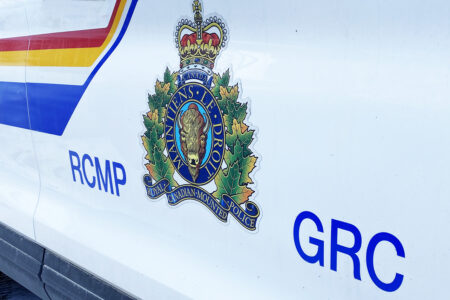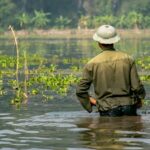TALES AND LEGENDS OF THE MOUNTAIN KINGDOM: A.S. Kerry, Lumber King, Comes to town(?)
If you can imagine it, our present townsite used to be covered with trees. A whole lot of logging and brush clearing had to go on in order to create space for buildings, roads, and people. And as you can imagine, there was no shortage of logable land in the surrounding areas outside the townsite, either.
Raw building materials were close at hand; the granite that was used to build the base of the post office was locally sourced, and the wooden houses, hotels, salons, and businesses were built from lumber also locally sourced. Lumber was big business, especially as the town grew, and there were a couple of lumber companies in town that made mints.
One belonged to Louis Blue, a native Hungarian who came to Rossland via Kettle Falls, a town he helped found. He built a saw mill at the foot of Red Mountain and was one of Rossland’s premier lumber suppliers, having been at the town site since it was a mere rough and tumble camp. Blue also had sawmills in Ymir and Greenwood, and utilized the local railway system, once it was in place, to move stock between locations. Harold Kingsmill describes Blue as “one of Rossland’s most promising and enterprising businessmen” and noted that although Blue had mining interests in town, those were secondary to his lumber business, and Blue liked to be called, “Blue, the lumber man.”
But Louis Blue had competition in Rossland, and it was not some small beans outfit that grew up in a grass roots manner. No, Louis Blue’s main competition came in the form of a huge company from Seattle infamous in the Pacific Northwest for it’s grand scale logging schemes. The company I am referring to is A.S. Kerry & Co. As Kingsmill put it, “there is probably no name in the Northwest better known to the lumber trade than that of A.S. Kerry.”
A.S. Kerry, AKA Albert Sperry Kerry, was a Canadian by birth, coming into the world in Kingston, ON, in 1866. He was one of 11 children born to Aaron and Matilda Kerry. Aaron was a carriage maker and blacksmith, and when Albert was a boy, the family upped stakes and moved to Michigan, where Albert completed his public school education and then went on to college.
When he was 20, he headed west and wound up in Seattle, saying later in life, “that village was as far west as I could go and still be in the United States.” It was there that Kerry got into the lumber business, starting out at a sawmill as a tally man, and then becoming a foreman. A few years later, he was managing a sawmill, and before long, he was a sawmill owner.
In 1896, he and his brother and another partner incorporated the Kerry Lumber Company, located in Seattle, but this wouldn’t last long: within a year, a fire ravaged it. But 1896 was also significant because that was the year the Kerry Lumber Company came to Rossland. It specialized in quite a few things, Kingsmill listing “rough lumber, kiln-dried finishing lumber, lath, shingles, doors, windows, lime, brick, etc.” Kingsmill also noted that the company was known for exporting lumber to China and Japan.
That year Kerry was also diagnosed with tuberculosis, and his doctors recommended he go and live in a colder, drier climate. So he headed to the Klondike, but not before incorporating another lumber business, the Kerry Canadian Mill Company. He arrived in the Yukon in 1898 and with his new company he set up a couple of sawmills in the area, and he got himself a steamboat called the Olive May (after his daughter), which would later become quite famous due to Robert Service’s poem, “The Cremation of Sam McGee.” But lo and behold, Kerry had actually been misdiagnosed – he didn’t have TB after all; so the family packed up its Northern household and hightailed it back to the more temperate climate of Seattle.
The other thing Kerry was well known for, aside from creating a seemingly endless list of lumber companies all over the Pacific Northwest, was the creation of the Kerry Line. In 1906 yet another lumber company was born, the Washington and Oregon Timber Company, located in northwest Oregon where Kerry and his business partner purchased “a billion board feet of timber, and later doubled their holdings”. But the problem was that the timber, which was in a river valley, was 25 miles south of the little town Kerry had started up to support the operation, and he needed a way to get the lumber to the town (which was called Kerry, incidentally).
So what did he do? He built a railroad. The Kerry Line, as it became known, was a particularly difficult line to build as there were a lot of gorges requiring a lot of bridges, and the terrain was very rugged. It took two years to build the first 25 miles of line, and by 1915 the line was finally hauling logs. By the late 1920s, the line was the longest logging railroad line in the Pacific Northwest, at 53 miles – and a whopping 35 bridges.
But back to Rossland. Once again, Kingsmill provides some details about the Rossland operation, in his typically florid manner. “The success of the Rossland house,” he wrote, “dates from its establishment, and it is safe to say that there have been few buildings that have been erected in Rossland since the beginning of the present year in which this house has not placed some of its material.”
My brother owns an original Rossland house, a plaster and lath building. Was it built with supplies from A.S. Kerry & Co.? We’ll probably never know.
Kerry died in April of 1939 from an apparent heart attack. In addition to his lumber career, he was also a very well known personality around Seattle. He has a park named after him and served on all kinds of boards. He was responsible largely for building the Olympic Hotel, now a Fairmont site, and the first TB sanitorium in the county.
It’s curious why Kingsmill included Kerry in his sketches of prominent Rosslanders circa 1897, because he does admit in the sketch that Kerry conducted the business of his lumber house in Rossland from afar in Seattle. Obviously his reputation was enormous enough to warrant mentioning in Kingsmill’s document. But did Kerry ever step foot in Rossland? Who knows?
Sources:
1. Harold Kingsmill’s sketch of A.S. Kerry, as seen here: http://www.ourroots.ca/e/page.aspx?id=274654
2. http://www.historylink.org/index.cfm?DisplayPage=output.cfm&file_id=8856
3. Harold Kingsmill’s sketch of Louis Blue, as seen here: http://www.ourroots.ca/e/page.aspx?id=274651

























